
The Burt Henry Covered Bridge, also known as the Henry Covered Bridge or just the Henry Bridge, is a covered bridge that spans the Walloomsac River near Bennington, Vermont. A Town lattice truss bridge, it carries River Road, just south of the village of North Bennington. Originally built about 1840, it was listed on the National Register of Historic Places in 1973 as Bennington County's oldest covered bridge. It was rebuilt in 1989 by the Vermont Agency of Transportation.
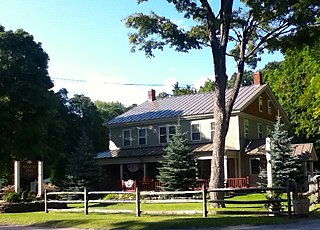
The Waybury Inn is an inn at 457 East Main Street in Middlebury, Vermont, United States. The inn was built in 1810, and is one of the oldest operating traveler's accommodations in the state. It was listed on the National Register of Historic Places in 1983. It is well known for its use in exterior shots of the Newhart television series.

The Bill Wilson House is a historic 19th-century hotel at 378 Village Street in East Dorset, Vermont, United States. Built in 1852, it is the birthplace and living memorial of Alcoholics Anonymous co-founder Bill Wilson. With 14 guestrooms and a conference room the non-profit bed and breakfast is a center for recovery seminars and regular AA and ALANON meetings. The property was listed on the National Register of Historic Places in 1995.
Shore Acres is a historic former summer hotel at 791 Lamoine Beach Road in Lamoine, Maine. With a possible construction history dating to about 1800, it is one of the coastal community's oldest buildings, and is the only surviving 19th-century hostelry in the town. Extensively altered in 1887 and operated as an inn between 1887 and 1942 as the Des Isles Inn, it is now a summer rental property, located within walking distance of Lamoine Beach State Park. The property was listed on the National Register of Historic Places in 2000.

The Governor Jonas Galusha Homestead is a historic homestead at 3871 Vermont Route 7A in Shaftsbury Center, Vermont. Built in 1783 and enlarged in 1805, it is a well-preserved example of Federal period architecture. It was built by Jonas Galusha, Vermont's fifth governor and a leading politician and military figure of southern Vermont for many years. It is now home to the Shaftsbury Historical Society, and was listed on the National Register of Historic Places in 1979.

The Jenks Tavern, also known historically as the East Rupert Hotel and the Hotel G. Jenks, is a historic public accommodations house at the junction of West Dorset Road with Vermont Routes 315 and 30 in Rupert, Vermont. Built about 1807, it is a well-preserved example of an early 19th-century traveler's accommodation in southern Vermont. It was listed on the National Register of Historic Places in 1994. The building is now a private residence, the home of American playwright and author John Nassivera.
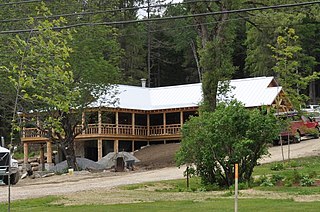
Johnny Seesaw's is a historic country lodge on Vermont Route 11, near the Bromley Mountain Ski Area in Peru, Vermont. Established in 1924, the lodge was an influential component of the early success of downhill skiing in southwestern Vermont, and is the place where events leading to the founding of both the National Ski Patrol and the United States Army's 10th Mountain Division took place. It was listed on the National Register of Historic Places in 2008. It is a full-service facility, offering accommodations, meals, and activities in all seasons.
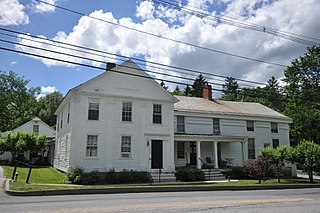
The Pratt-McDaniels-LaFlamme House is a historic house at 501-507 South Street in Bennington, Vermont. Built about 1800, this Federal period building encapsulates the changing residential trends in the town over a 200-year historic, starting as a farm house, then that as a businessman, and eventually subdivided into worker housing. It was listed on the National Register of Historic Places in 2002.

The School Street Duplexes are a pair of historic two-family worker houses at 343-345 and 347-349 School Street in Bennington, Vermont. Built about 1916, they are well-preserved examples of typical worker housing units of the 1910s. They were listed on the National Register of Historic Places in 2007.

The Twing Bucknam House is a historic house on United States Route 5 south of the main village of Windsor, Vermont. Built about 1840, it is a modest brick house with a combination of features that is unique to the state and the surrounding communities. It was listed on the National Register of Historic Places in 1996.

The Wales N. Johnson House is a historic house at 43 Senior Lane in Woodstock, Vermont. Built in 1889-90 by the owner of a local sawmill, it is a high quality example of vernacular Queen Anne architecture. Now serving as the Jackson House Inn, it was listed on the National Register of Historic Places in 1995.

The Charles Marsh Law Office is a historic building at 72 Hartland Hill Road in Woodstock, Vermont. Now a private residence, this moved and altered structure, built about 1797, is the oldest surviving example of a detached law office in the state. It was built for lawyer Charles Marsh, and is where his sons George Perkins Marsh and Lyndon Arnold Marsh trained for and/or practiced law. The building was listed on the National Register of Historic Places in 1994.

The Spencer Hollow School is a historic school building at 50 Spencer Hollow Road in Springfield, Vermont. Built about 1810, it is a fine local example of a district schoolhouse. It was used as a school until 1926, and as a clubhouse for a time thereafter. It was listed on the National Register of Historic Places in 2012.
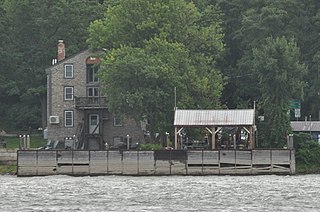
The Larrabee's Point Complex consists of a collection of ferry-related buildings and structures at the western end of Vermont Route 74 in Shoreham, Vermont. Included are facilities currently used by the oldest operating ferry on Lake Champlain, the Ticonderoga-Larrabees Point Ferry, and two buildings historically associated with the ferry operation. The complex was listed on the National Register of Historic Places in 1980.

The Normand House is a historic residential property at 163-65 Intervale Avenue in Burlington, Vermont. Built in 1869 as a single-family and enlarged into three units in 1890, it is a well-preserved example of period worker housing. It was listed on the National Register of Historic Places in 2008.

The Darling Inn is a historic former hotel building in the center of Lyndonville, Vermont. Built in 1927–28, it is a rare example in the state of an architecturally neo-Federal building, and one of the last major constructions during the state's Colonial Revival period. Now converted to a senior care facility, it was listed on the National Register of Historic Places in 1980.
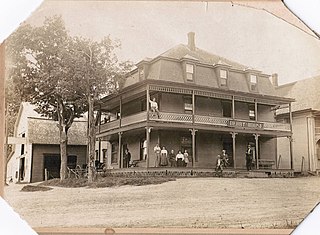
The Derby House Hotel is a historic former hotel building at Main and West Streets in Derby, Vermont. Erected in 1896, it was for many years an important element of the social and commercial life of the small community. Now converted into apartments, it was listed on the National Register of Historic Places in 1998.

The Lakeview Inn is a historic tourist accommodation at 295 Breezy Avenue in Greensboro, Vermont. Built in 1872 and enlarged several times, the inn illustrates the evolutionary changes in tourism of northern Vermont. It was listed on the National Register of Historic Places in 2000.
The E.J. Bullock Block is a historic commercial building at 7012 Main Street in Readsboro, Vermont. Built in 1891, it is a prominent local example of Second Empire architecture, with a long history of commercial, social, and civic uses. The building was listed on the National Register of Historic Places in 2021.
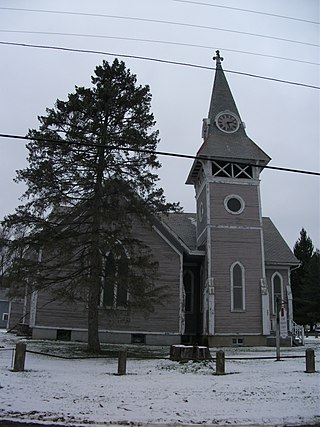
The Rupert Village Historic District encompasses the 19th-century village center of Rupert, Vermont. Extending along Vermont Route 153 and adjacent roads, the village preserves a 19th-century landscape and a variety of structures important in the life and economy of the period. The district was listed on the National Register of Historic Places in 2022.





















